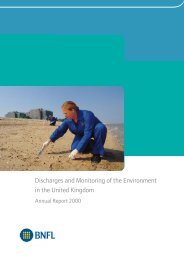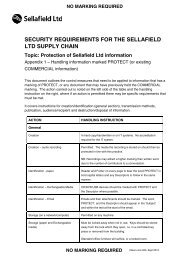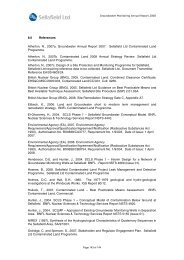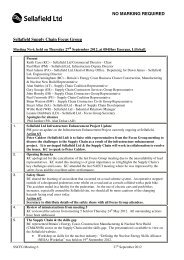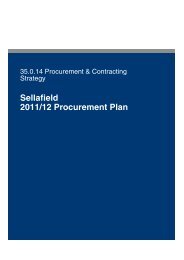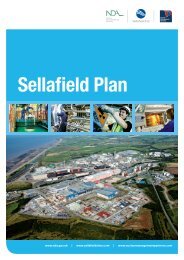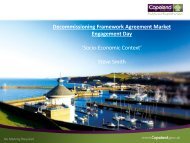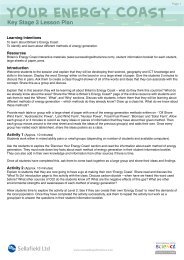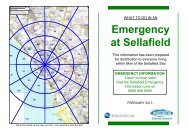Annual Report for 2010/11 and Forward Programme - Sellafield Ltd
Annual Report for 2010/11 and Forward Programme - Sellafield Ltd
Annual Report for 2010/11 and Forward Programme - Sellafield Ltd
Create successful ePaper yourself
Turn your PDF publications into a flip-book with our unique Google optimized e-Paper software.
surface. This is a direct consequence of the relatively large field of view of the airbornesystem compared to the dimensions of the patch. Ground based approaches, with significantlysmaller fields of view <strong>for</strong> the detectors, are better able to distinguish signals from extendedpatches of background activity with these dimensions <strong>and</strong> discrete particles, although asimilar ambiguity between discrete sources <strong>and</strong> dispersed activity would still exist <strong>for</strong> smallerpatches. The use of collimated detectors or self-collimated detector arrays in airborne surveycould be considered to improve the ability of such systems to identify discrete particles inenvironments with patches of enhanced activity.With several patches of activity in a given area, an intermediate situation exists where <strong>for</strong> lowdensities of patches the problems of distinguishing between a patch of activity <strong>and</strong> a sourcedominates, <strong>and</strong> at higher densities of patches the environment approaches one where the 137 Csbackground is uni<strong>for</strong>m.SourceSuperficial137 CsBuried137 CsSuperficial241 Am137 CsBackgroundDetection Limit (MBq)Rapid Survey Low <strong>and</strong> Slow 4 knots3σ 2σ 3σ 2σ 3σ 2σ0 Bq kg -1 9 5 0.23 0.14 0.050 0.03050 Bq kg -1 10 6 0.28 0.17 0.065 0.0370 Bq kg -1 35 20 1.00 0.60 0.22 0.1450 Bq kg -1 39 23 1.20 0.75 0.29 0.170 Bq kg -1 n/d n/d 1.5 1.0 0.35 0.2250 Bq kg -1 n/d n/d 2.0 1.3 0.45 0.30Table 4.1: Predicted detection limits <strong>for</strong> 137 Cs <strong>and</strong> 241 Am <strong>for</strong> the medium naturalbackground condition <strong>and</strong> 50Bq kg -1 137 Cs uni<strong>for</strong>m background.4.2 Response to recovered particlesThe March 2000 coastline survey flight has been recreated <strong>for</strong> the section between St Bees<strong>and</strong> Duddon, by generating natural series spectra from the simulations conducted in the firstphase of this work scaled by the measured activity concentrations <strong>and</strong> simulated spectra <strong>for</strong>the sources recovered from the beaches. For both 75m <strong>and</strong> 15m ground clearance data alongthe flight lines of the March 2000 survey, the recovered sources contribute no counts to thespectra. The recovered particles are all below detection limits <strong>for</strong> the 75m survey, <strong>and</strong> eventhe cumulative spectrum from several sources is below detection limit. A few (3) of therecovered sources have activities above 200kBq <strong>and</strong> were recovered from the top 10cm of thebeach. These particles were all recovered from the <strong>Sellafield</strong> <strong>for</strong>eshore. These should bedetectable using a slow survey at 15knots or less <strong>and</strong> 15m ground clearance, especially withclose linespacing. A few more (2-3) may have been detectable under such detailed surveyconditions. The survey flights in March 2000 were too fast, too high <strong>and</strong> too far apart toobserve them.Residual spectra have been produced by subtracting the simulated natural spectra from themeasured spectra <strong>for</strong> the March 2000 survey. The count rates within a window around the137 Cs peak in these spectra have been mapped <strong>for</strong> sections of beach at St Bees, Seascale <strong>and</strong>Drigg. These show distributions that correspond reasonably well to the 137 Cs activity per unitarea determined in March 2000, although there are some differences in the spatial31



